When a Japanese product planner working for Brother Industries Ltd (BIL)., the parent company of Brother International Corporation in Bridgewater, New Jersey, “dreamed” big, he could not have imagined the outpouring of international support he would receive. Last March, after the devastating earthquake and tsunami in Japan, Shigeyuki (Joe) Abe, a product planner at Brother Industries, Ltd.,in Nagoya, Japan desperately wanted to help. His idea to create tote bags for the children who had lost everything in the devastation was drawn from two personal experiences. At home, Abe had made cloth tote bags for his own eight-year-old son who used them to carry books and supplies on his walk to school. At work, Brother Industries Ltd., a leading international diversified manufacturer of industrial products, home appliances, and business products had an award-winning line of sewing and embroidery machines which the company began to manufacture as its first product in 1908
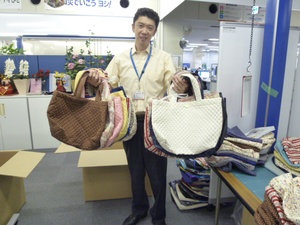
Brother product planner Shigeyuki (Joe) Abe, who created the Dream 1000 project, is surrounded by donated tote bags.
“I felt that tote bags would be the most beneficial for the kids who go to elementary school to carry a lot of items such as shoes, clothing, books, etc.,” says Shigeyuki (Joe) Abe. “It is also convenient to use these bags for shopping, especially for the parents.”
By using his experiences from home and work, Abe began to wonder if he could encourage his fellow employees to produce simple sewn tote bags for the afflicted Japanese children. Taking his idea to his managers at work, the idea quickly took root and became a worldwide project for Brother’s international workforce. Management at Brother was confident that its family of dealers would help make Abe’s dream a reality since it reflected the company’s strong dedication to leadership and commitment as well as to its Japanese roots.
The incomprehensible terror and destruction began on March 11, 2011 when a strong earthquake measuring 9.0 on the Richter scale struck off the Pacific coast of Japan, followed by severe aftershocks. It was the most powerful known earthquake ever to hit Japan and one of the five most powerful earthquakes recorded in the world since modern record-keeping began in 1900. The earthquake triggered powerful tsunami waves that reached heights of up to 133 feet causing devastating human and structural damage in northeastern Japan and destroying entire cities in the coastal prefectures of Fukushima, Iwate and Miyagi.
The disaster damaged or destroyed more than 700,000 commercial and residential properties, leaving thousands of families homeless in the middle of winter. According to Save the Children1, an international humanitarian organization, the crisis in northeastern Japan directly affected more than 100,000 children through displacement, loss of access to education, loss of family members, and exposure to high levels of stress and anxiety.
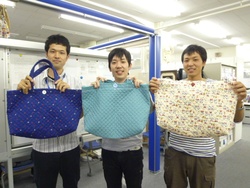
Three young engineers from Brother Industries, Ltd. headquarters display some of the donated tote bags to the Dream 1000 project.
As a result of this catastrophic event, Brother embraced Abe’s idea a few weeks after the disaster and officially named it the Dream 1000 Project. Brother began asking its worldwide employees and authorized dealers to join in the effort to produce 1,000 hand-decorated fabric tote bags for children to carry their belongings. By late December 2011, completed bags from the U.S. as well as Canada, Mexico, Brazil, Denmark, U.K. and Taiwan, were shipped to BIL. In total, more than 2,278 tote bags were produced and shipped, well above the anticipated original goal. Finally, BIL delivered all tote bags for children who live in Shichigahama-cho, Miyagi by late March 2012.
Part of the allure of producing the bags was its easy pattern to follow. Participants say the bags took no more than 45 minutes to produce, depending on how much unique embroidery, quilting, or appliqué was added. The bags measured 20" x 20" and were made of heavy, durable fabrics like denim or canvas and had handles and a closure of either a button or hook and loop fasteners.
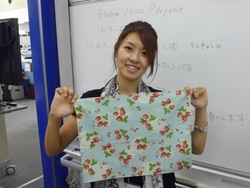
Mana Suzumori, a Brother Industries Ltd project member, displays some of the colorful fabric used for the donated tote bags.
Throughout the summer and fall of 2011, Brother employees, dealers, and customers from 17 U.S. states gathered together to produce the tote bags. Dealers from across the country found unique and creative ways to organize their “project playground.” Most dealers said they set up an ‘assembly-line’ to make the process go quickly by pre-cutting the patterns and lining up their Brother sewing, quilting and embroidery machines. This allowed for a more relaxed atmosphere and opened the door for fun and camaraderie.
As word spread nationwide, the response was overwhelming. Here in the U.S., project leaders set a goal of 100 tote bags but far surpassed that number. Dean Shulman, Senior Vice President of Brother International Corporation and head of the Home Appliance and Industrial Products Divisions, asked for 300 tote bags from his associates around the country. “In the end, our employees, dealers, and customers answered our request in an even bigger way and sent us 524 tote bags for the relief effort,” says Shulman. “They completely surpassed our goal of 300. One dealer even sent 70 bags.”
Everyone banded around the call. Quilters from around the world took part in the project, creating bags during the Houston Quilt Show in November 2011. Terry Koike, president of Brother Industries Ltd, participated in the project by making a bag, as did Brother International Corporation’s president, Tadashi Ishiguro and his wife. Brother International Corporation’s Dean Shulman made a bag and decorated it with glitter, a guitar, and handwritten message, “To Our Heroes in Japan from Your Brothers in the U.S.A.” Another donated bag was embroidered simply with the words “Love, love, love.”
“Sewers and crafters are very compassionate, giving people,” says Shulman. “They used their Brother sewing machines to send hopes, dreams, and love to the children of Japan by creating these essential multi-purpose school bags. A year after the disaster, the Japanese people still face basic needs to rebuild their lives.”
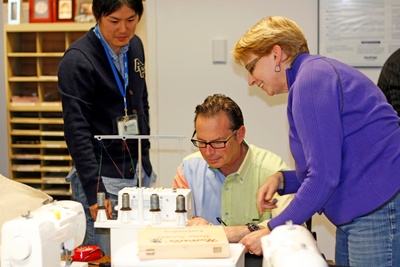
Dean Shulman (center), senior vice president of Brother International Corporation and head of the Home Appliance and Industrial Products Divisions, created his own tote bag for the Dream 1000 project.
Creative Threads, a family-owned two-store dealership in Binghamton and Greene, New York, contributed 12 bags to the project. A note accompanying their donation said, “We send our thoughts and prayers for those in Japan impacted by the tsunami. We hope that these bags will help bring some joy to the children affected by this tragedy.”
Amy Phipps, an employee at Creative Threads, joined four others who produced the school bags. “We thought it was a great idea on Brother’s part to extend this invitation to make the bags and help the children. They are so far away in Japan and you don’t know what to do to help. You can contribute money but it seems so impersonal. Knowing that these bags are needed gave us the opportunity to help out, especially for the children who sometimes seem to be forgotten.”
The five from Creative Threads found the pattern very easy to follow. They enjoyed, said Phipps, being able to customize the bags for either boys or girls using their own fabrics and embroidering Disney characters on some of them.
At sewnow! in Lafayette, California (outside of San Francisco), co-owner Susan Goldie assembled her pre-teen and teen sewing class to produce the tote bags. The 22 teens worked at different stations and produced 20 bags for the project. “Our core business is to teach sewing skills to children and adults,” says Goldie. “We incorporated the project into our teen sewing class. The kids found it super fun to make the bags and they were aware of the disaster in Japan and felt it important to help other children.”
Goldie’s group produced tote bags for both boys and girls using blue and grey denim fabric and accessorizing them with floral or plaid straps. The more experienced sewers took the roles of precision sewing techniques such as top-stitching and button holing whereas the new sewers produced straight-line stitches. “We even had a few guys come to work on the tote bags,” recalls Goldie. “They are usually more interested in the technology behind the sewing machines. This project really highlighted that area on our Brother machines since we used the Quattro® 6000D model with the scanner and camera-like features. The Brother machine also has hundreds of built-in embroidery designs that we could use on our tote bags and that captivated their interest.”
Rhonda Lopez, owner of four Nuttall Bernina Sewing Center’s in the Salt Lake City, Utah area donated a total of 104 tote bags. “I was excited to hear about The Dream 1000 Project,” said Lopez. “I contacted the managers of all four locations and asked them to come up with their own events.”
One location invited home economics students from a local school to make the bags. The teachers gave the students extra credit for their participation and the students came in one day after school and on a Saturday. Another location asked the Boy Scouts to participate. It not only helped the cause, but it qualified to help the boys meet their requirement for their sewing badge. The other two locations created a Dream 1000 sewing night and invited customers to come in and make the bags. The rooms were set up with all Brother machines for design and embroidery, and participating customers would earn a coupon toward a purchase in the store.
Lopez has operated her family-owned business for over 15 years and says she’s proud to be a part of the Brother family. As an Authorized Brother Dealer, she wants to thank Brother for creating The Dream 1000 Project. “Brother has been there for us every day, supplying us with state-of-the-art sewing machines, outstanding service and their commitment to excellence. Participating in this cause is our way to show our appreciation and to give back not only to Brother, but to the children in Japan who continue to struggle in the aftermath of the earthquake.”
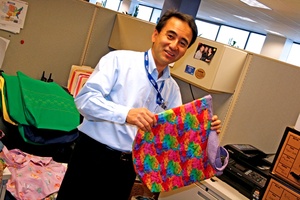
Brother International Corporation's president, Tadashi Ishiguro, admires the many tote bags produced for the Dream 1000 project.
Although the earthquake in Japan occurred a little over one year ago, the need for assistance continues to be ongoing. Rebuilding after a catastrophic event can take years, even decades before life, business and infrastructure are back to normal. Brother realized this need and recognized that something as simple and basic as a tote bag can light up a child’s life. “Possibly everything the child owns will fit into that bag,” said Shulman. As for Brother product planner Shigeyuki (Joe) Abe, his dream is complete. His desire to help fellow Japanese citizens became a successful international project in which people around the world gathered to help those in their time of need.
Notes:
1. Save The Children (April 2012)
© 2012 Debora Toth



